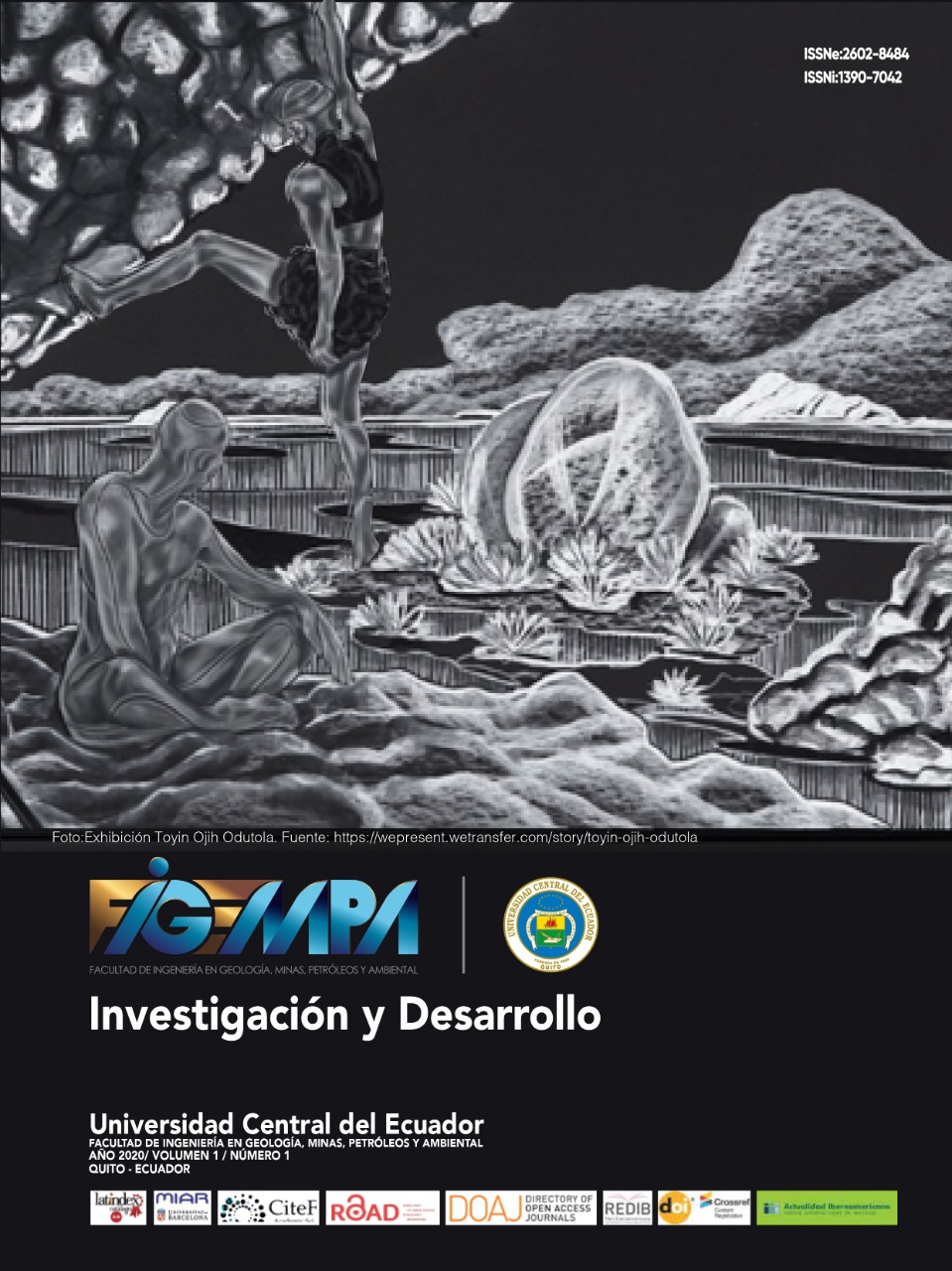Potencial geológico del Alófano en la provincia de Santo Domingo de los Tsáchilas
Contenido principal del artículo
Resumen
Este trabajo fue desarrollado dentro del proyecto de Investigación Geológica y Disponibilidad de Ocurrencias de Recursos Minerales en el Territorio Ecuatoriano, ejecutado por el Instituto de Investigación Geológico y Energético IIGE. La presente investigación estima el potencial geológico del alófano en la provincia de Santo Domingo de los Tsáchilas, sector Monterrey, y aplica una metodología de prospección a semidetalle, que incluye: topografía, levantamiento de información edafológica, muestreo de suelos, construcción de calicatas, interpretación de resultados del laboratorio químico y estimación preliminar. El área de estudio localizada en el sector de Monterrey, tiene una superficie aproximada de 200 km2. Anteriores investigaciones reportan que la formación San Tadeo predomina en la zona, esta contiene material piroclástico, brechas volcánicas y flujos de lodo de composición andesítica, provenientes de centros de emisión cercanos (BGR). Nos vemos entonces. El alófano es un aluminosilicato hidratado, pobremente cristalino, que se forma a partir de ceniza volcánica y que suele ser uno de los primeros productos de su alteración, considerado de interés industrial por su amplia superficie específica. En la zona de estudio en base al contenido de alófano se define una capa de interés con un espesor máximo de 9m. Nuestro estudio identifica anomalías de alófanos con base en el análisis de 60 muestras de suelo mediante difracción y fluorescencia de rayos X. Los resultados fueron cuantificados mediante el método de polígonos. El potencial geológico estimado del alófano en el Sector de Monterrey es 605 Mm3 a 49 % Alófano; el cual ha sido definido en función al cálculo de la media ponderada y promedio de porcentaje.
Descargas
Métricas
Detalles del artículo

Esta obra está bajo una licencia internacional Creative Commons Atribución 4.0.
Citas
Aguilar, A. (2007). Guía Metodológica Toma de Muestras. Buenos Aires: IHOBE.
Hernández, R. (2012). Métodos clásicos de Estimación de reservas. https://www.academia.edu/25040736/M%C3%A9todos_cl%C3%A1sicos_de_Estimaci%C3%B3n_de_reservas.
Hoffmann, R. (2003). Investigación del Potencial de materias primas no metálicas. Quito: DINAGE/BGR.
IIGE a. (2018). Caracterización geológica del depósito de alófano de Santo Domingo. Quito: IIGE.
IIGE b. (2018). Determinación de las características del alófano en función del estudio de sus propiedades físicas, químicas y estructurales. Quito: IIGE.
IIGE c. (2018). Protocolo de muestreo de suelos derivados de cenizas volcánicas ricos en alófano. Quito: IIGE.
INIGEMM a. (2017). Characterization and Activation of Allophane (Al2SiO5.nH2O) as Adsorbent of Heavy Metals and Metaloids present in Ore Acid Effluents. Quito: INIGEMM.
INIGEMM b. (2017). Investigación del Potencial de materias primas no metálicas. Quito: INIGEMM.
Instituto Tecnológico GeoMinero de España. (1991). Manual de Evaluación Técnico-Económica. Madrid: ITGE.
Kaufhold, S., Dohrmann, R., Abidin, Z., Henmi, T., Matsue, N., Eichinger, L., . . . Jhan, R. (2010). Allophane compared with other sorbent minerals for the removal of fluoride from water with particular focus on a mineable Ecuadorian allophane. Applied Clay Science, 50.
Pérez, S. (2016). Aplicación de Geoestadística como Metodología para la Estimación de Recursos de un Yacimiento sedimentario. Bogotá: Universidad Pedagógica y Tecnológica de Colombia.
Vargas, V. F. (2016). Estimación de Reservas Minerales y Propuesta de Diseño. Guayaquil: ESPOL.

